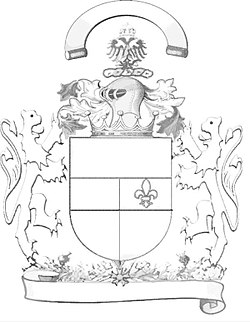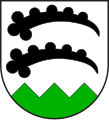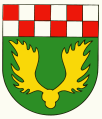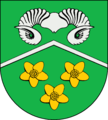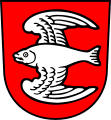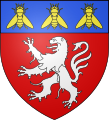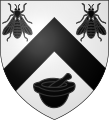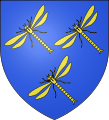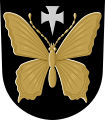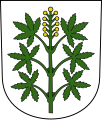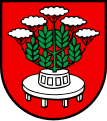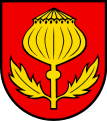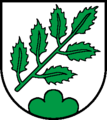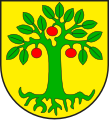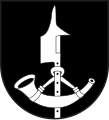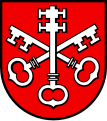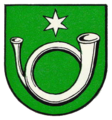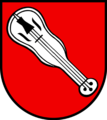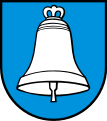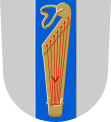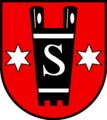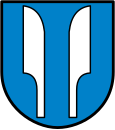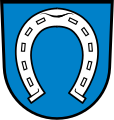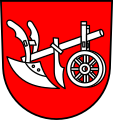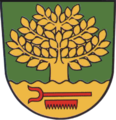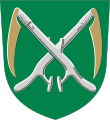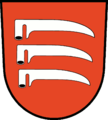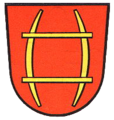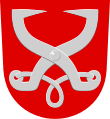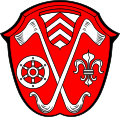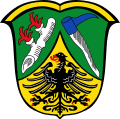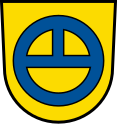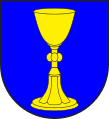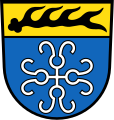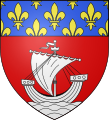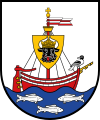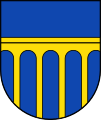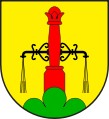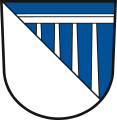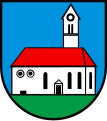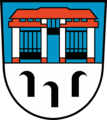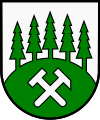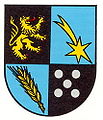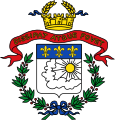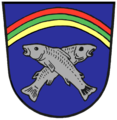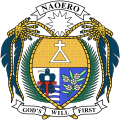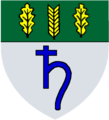Common figure
In heraldry, the common figure is a representation element for designing the coat of arms as part of a coat of arms .
In principle one understands by common figure all visually "perceptible appearances" of the real world. They are in contrast to the Herald's picture , which consists of a simple geometric division of the shield by dividing lines that divide the shield into differently colored "places". Many heraldic shields combine heraldic images with common figures. Common figures can be shown in natural colors , although this should be avoided. The heraldic rules prescribe the most extensive stylization possible with the best possible recognizability of the motif. Basically, the space of the shield or field is filled as much as possible, so the heraldic figure in the shield extends almost to the edge of the shield.
Living beings that are depicted outside the shield are considered shield holders and are not to be viewed as mean figures. The following can serve as templates for common figures:
People
Human figures
Human figures form people of both genders and all ages, naked or clothed, often with work clothes (e.g. knight , craftsman , bishop etc.), as representatives of different ethnicities or nations (recognizable by stereotypes or traditional clothing), often their own, but also others (e.g. Moors , Turks in Hungarian heraldry ), as full, partial or portrait views.
Bathers in Baden
Bathers r in Bad Liebenzell
Woman in traditional Dithmarsch costume ( Nordhastedt )
Children in Gimel VD
Kaiser ( Waischenfeld )
crowned Mohrin ( Illerkirchberg )
Farmer with Bundschuh flag , ( Westheim )
people
Specifically named people can also represent heraldic figures. Often these are saints with their iconographic attributes (see Christian symbols in heraldry ). There are also characters from Greek , Roman or Nordic mythology .
Karl Borromäus ( Cunter , Graubünden)
St. Georg ( Waltensburg / Vuorz , Graubünden)
Glückstadt : Fortuna with sail
Adam and Eve in Baja (Hungary)
Hephaestus as a blacksmith ( Elektrostal )
St. Fridolin von Säckingen ( Canton Glarus )
Mythological and mixed characters
These are mythical creatures
Greif ( Greifensee ZH )
Wilder Mann ( Klosters-Serneus , Graubünden)
Mermaid ( Warsaw : Mermaid of Warsaw )
Virgin eagle ( Mücke , Hessen)
parts of the body
These are e.g. B. arm , hand or leg, also armored or with additional objects or clothing components, including hearts , bones or skulls. In a broader sense, it also includes tears or blood .
Auge ( Au am Rhein , until 1978)
Three legs ( feet )
Heart (Külsheim- Uissigheim )
Tongue and halo of Johannes Nepomuk (Vienna- Brigittenau )
Gestures
Here a hand or hands expresses a meaning through their specific posture, e.g. B. the raised hand or the sworn hand with the palm of the hand facing the viewer.
Hand of oath ( Gempen , Solothurn)
Animals
When choosing the heraldic images, traditional folk symbols such as the white saxon horse or the swan and old animal helmets were often used .
- Animals, mainly vertebrates, most often mammals ( lion , bear , leopard , panther , deer H , dog H , bull H ) and birds ( eagle , double-headed eagle ), less often fish H , reptiles mostly as snakes , very rarely invertebrates, for example Bees, beetles, shells , also popular mythological figures and mythical creatures ( unicorn , pegasus , centaur , griffin , dragon , basilisk etc.), also body parts of animals such as deer sticks , horse's head H , wings H etc.
- The correct interpretation of the coat of arms is important for the sheep in the coat of arms. It can lead to errors: sheep or agnus dei . Agnus Dei or God's Lamb is firmly rooted in religion , while the simple sheep only stands for keeping and breeding.
Horns and antlers
There are coats of arms with one and also with several horns, in a natural appearance, slightly tapering and curved, with a thickened beginning (“rooted”), with deer (“rosette”) and sheep often depicted like a cloverleaf. If, like a hunting trophy, a piece of bone is depicted from the base of a couple's horns, it is called "horned (with grind)". Deer are presented naturally with ends, sheep, goats and ibexes as gnarled. Horns and antlers in the upper coat of arms are consistently paired, used in all tinctures and with all infections (jewelry).
Mythically horned common figures are also derived, such as fish with antlers, as well as horn products, mainly blowing (hunting) and drinking horns, which differ from the natural horn by the cord and fitting.
a cattle horn ( Krasiczyn PL)
two buffalo horns in silver and black
rooted ibex horns
curved black deer pole with a clover-leaf grind
Buck horns (ram, heraldically abstracted)
upright nine-sprouted fallow deer shovel
Special heraldic animal parts
two turned away black unicorn hulls that have grown together
Fish with reindeer antlers
arthropod
Arthropods , mainly insects , are only represented in a few species in heraldry . Bees are particularly widespread in French heraldry . It was due to Napoleonic heraldry , which tried to replace the lily in the coat of arms with bees. They were also a distinguishing feature for the “ good cities ” of the time. Other than bees, other insects have not become widely used in heraldry. Ants and flies are sparse . Even the beauty of butterflies has not changed the limited representation. The coat of arms of the silk industry shows a silk moth .
- Examples
- Further examples
Arachnids are even rarer . The scorpion in the coat of arms is also a rare heraldic animal .
Mineralogy and fossils

Stones can be found as a coat of arms. In addition to the field stone, there are especially the crystal (in the form of the rock crystal ) and the diamond (shown in various cuts). In addition, the gemstone is also called facets diamond emblazoned or polished diamond.
Fossils as common figures are rare. Only a few forms of fossilization are suitable for generally recognizable symbolism. Mainly ammonites are depicted, alongside trilobites as important key fossils of the Paleozoic Era. The application is to be ascribed to the more recent times, when pedological studies gained greater weight in science.
plants
- Plants, especially flowers ( rose , lily ) and trees , also components such as flowers, leaves and fruits. The representation of the leaves ranges from single leaves to whole wreaths.
- In the case of grapevines , the entwining of the tendrils is heraldically particularly attractive. The grape is represented in color or metal . Arrangement in the escutcheon or field can be single, two over one, side by side or in a radial shape from the center. Of the inconspicuous plants, the clover, especially the shamrock, has found its way into heraldry. It can be found as a single sheet or as part of crosses and coats of arms .
- Other frequently used, stylized leaves are the linden leaf , the sea leaf , the oak leaf and the nettle leaf , which because of its shape filling the shield cannot be clearly assigned to the heraldic images or common figures.
- The palm frond is often held by figures in the coat of arms, but is also placed around the shield and used as a crest ornament . The palm frond is the attribute of the martyr .
Trees
The trees that are often chosen are strong oaks, old venerable linden trees, beeches and maples with their characteristic leaf shape. If the tree is represented with roots, then it has been "torn out". This allows for a different color for the roots. Even tree stumps are popular in heraldry.
The stylized double oak has found its way into heraldry. The tree has two trunks, which have often grown together in the lower part ( Zwiesel ) and form a common crown.
Other plants
a mushroom with a brown hat
Flowers and fruits
Kemel with two rose petals in a flower pot
golden brown Hutzel ( dried pear ) or Kletze
Porter with a bunch of veal
Stylized plants
Trunk with stumps
Objects
- Objects in the form of all kinds of everyday equipment (weapons, tools, household appliances), often in the form of attributes of saints, e.g. B. one or two keys for St. Peter , but also insignia such as crowns, sceptres, bishop's staff.
- Wendelring : The ring is a find from the Hallstatt period and comes from a grave in Oberhausen . Places that have this ring in their coat of arms are in addition to Oberhausen: Bonefeld , Hecken (Hunsrück) , Oberhausen bei Kirn . Special versions in the royal tomb of Seddin .
weapons
- See also bow and arrow , sword (heraldry) , crossbow (heraldry) , polearm (heraldry)
- The climbing tree is a medieval ladder shape for the craft of war with only one stile and rungs on both sides. Very rare in the coat of arms. An example is the community of Löwenberger Land .
- Judgment wheel with sword indicates jurisdiction. The wheel was used for punishment by wheels and the sword shortened life. This sign is not very popular in coats of arms due to the executioner involved. Berlin-Weißensee showed it as the city district coat of arms with the Berlin wall crown .
Straightening wheel with sword
crossed swords
Crossed morning star and halberd
insignia
- Some coats of arms, especially in the German-speaking area, use insignia as a coat of arms figure. Often this happens due to the past as a free imperial city or free imperial village of the Roman-German Empire .
clothing
- See also: shoe and boots , cowl (clothing) , clasp (heraldry) , hat (heraldry) , helmet (heraldry)
- Many items of clothing appear more frequently in the coat of arms. This includes the shoes, gloves and other items of clothing. Armored legs, but also arms are called armored legs and armored arms . If the hand is clad in armor, it is an armored right or left hand. All forms can also be found as tripods or triquetra in coats of arms.
Glove (in the coat of arms of Hendschiken )
Glove, see also Herren von Handschuhsheim
Helmet with coat of arms
Meier hat
Storm hat
Books
Musical instruments
- Many musical instruments are chosen as a picture in the coat of arms . The violin , harp , organ , drum and wind instruments are important, as is the case with signal horn : hip horn , post horn , hunting horn and bagpipes . The latter is also played here .
- The horns are preferably in gold or silver. Carrying straps on the hip horn are differently colored and draped. Cords and tassels on the post horn are also highlighted, see list . For many, the instrument form ends in a "fun head". The neck of the violin can take on the shape of a face.
- A golden harp in the British royal flag is fused to the instrument with a winged naked female body looking to the right.
Harp with grimaces
Agriculture and tools
- Of the agricultural implements, the plow and harrow can be found in stylized form on the shield. Often times, the bearer of the coat of arms is content with just the ploughshare in the coat of arms. The part of the plow is often shown individually, in pairs, two-to-one or in a pile, in a bar or in a slant on the sign.
- Everything is used for small tools. So the sickle, scythe and scissors, as well as ax and knife are a welcome mean figure.
- As a sign of mining, mallets and irons can be found in many coats of arms of the coal and ore fields. They testify to hard work, but also to the economic success that resulted from the activity that determined the region. The characters (mallets and irons) are often adapted to the excavated material. Insignificant for heraldry. Coats of arms can also be found in which symbols have been used for certain conveyed goods. These were developed by the scientist Mikhail Lomonossow and Dmitri Winogradow . An example is the circle with a horizontal "thread" through the center (for example in the coat of arms of Bachmut ). It stands for salt, but also has the meaning of an old measure of capacity, the sester .
- Harvest baskets with fruits, wine barrels and jugs are not uncommon. Jugs are held by living beings or poured out like horns of plenty. But also horns of plenty themselves (coat of arms of Hengelo / NL.)
- Hammer and sickle found and are used for politically emphasized coats of arms. Example: the GDR and the Soviet Union including other states in their sphere of influence. The combination with other elements (ears of corn, compasses, cogwheel, hoe, Kalashnikov and others) shaped this heraldry. The same elements were depicted on flags. Crossed with one another, the hammer and sickle represent a symbol of communism . Separately, they are found in the two claws of the Austrian eagle and form a group of three with the crown of the wall.
- Horseshoes can be found in many coats of arms as they are considered a symbol of luck. They are shown with the open side (stud side) down, otherwise they are "upside down" or "overturned". They are described as “nailed” when the hoof nails differ in color from the iron. Horseshoes are also often "covered" or "decorated" with other herald images.
- Reute is a tool for clearing forests.
- Cow irons: In the past, the outer claws of ruminants were often shod with special irons to protect them from excessive wear. Around Amt Menden (Sauerland) many places have the cow iron in their coat of arms.
- The farmer or craftsman (heraldry) can be found as a figure
Miner's hammer
Pickaxe and Handfäusteln
two cross-laid Reuten
Soap fork and horse comb in the shield base
Wine ladder or rest
Cow iron in the lower shield
crossed salt hooks
Farmer with a hoe
Sapie , top right
Other devices
Sweeping nail
Kesselring or cling
Salt küfe (see also salt (heraldry) )
Libra ( Rockeskyll )
Vehicles and wheels
- Vehicles, especially water vehicles such as ships and boats , rarely land, air vehicles or railway symbols .
Ferry ( Bonn-Beuel )
Watercraft ( Paris )
Boat ( Tuggen , Schwyz)
Carriage ( Kopřivnice )
- Wheels , whole or only parts of the wheel have a particularly wide-ranging meaning and are not followed by the other heraldic figures in their use in the coat of arms. Special forms are, for example, the straightening wheel and the Mainz wheel . The wheel is also an iconographic attribute of St. Catherine .
half wheel ( Radeberg )
Mainz Wheel ( Mainz )
Wagenkipf or Wagenrunge ( Kipfenberg )
Buildings
- Buildings, especially towers and walls of cities, but also wells, as well as individual components such as gates and gables are to be assigned to the section.
- The towers and walls of cities, summarized in heraldry under the name of a castle, serve to symbolize political independence and defensiveness against princely claims to power. Groups can also be formed: castles, individual towers and columns , walls, churches and bridges .
- Many coats of arms show fountains . The municipalities and cities are often health resorts or have bathing status. The description of the coat of arms gives clues.
- Places near the coast often show a lighthouse in their coat of arms .
- As an old building and factory building, mills have found their place as wind and water mills in the coat of arms. The individual parts such as the millstone , mill iron and mill wheel are particularly popular.
- A particularly unusual example is provided by the coats of arms of North Korea and Kleinmachnow , which have a hydroelectric power station and a high-voltage pylon or a lock in the coat of arms.
- The coat of arms of Dollbergen leads on the right side the distillation towers of an oil refinery , which together with the potato plant on the left side are supposed to symbolize the transition from the farming village to the industrial village.
- Ovens
stylized railway viaduct from Altenbeken
Distillation towers of a petroleum refinery
Megalithic tomb
landscape
Mountains and rivers
- Landscape components , mostly as mountains, such as the Dreiberg or rivers , which are combined as wave sections with other display elements.
Astronomical objects
Crescent moon and stars
Meteorological phenomena
This includes the stylized weather-related phenomena of cloud , rainbow , wind and lightning. The first two named can, if they touch the edge of the shield, also appear as a herald image in the coat of arms. The herald's image cloud is used as a field-filling (here as a tincture ) or cut-forming heraldic pattern. The lightning bolt is also used as a symbol for the electrical industry in newer coats of arms. The use of meteorological phenomena is low in heraldry.
Religion in the coat of arms
Crosses
Favorites are crosses as symbols. A heraldic cross is considered a common figure when it is free in the shield. When the arms touch the edge of the shield, however, it is to be regarded as a herald image .
character
Alchemical signs and planet symbols
Alchemical signs had two different meanings in heraldry in the past. On the one hand they were used to mark heraldic tinctures, and on the other hand they were used as a common figure in the coat of arms. Instead of hatching, the symbols of the planets were also used. The English Speelmann used these symbols around 1600.
These are the usual color attributions of alchemical usage, as they were common at this time, with the exception of Mercury (mercury), which usually represents luster - according to the early color theories, not as such differentiated from colors. Here their function was to be assigned a symbolic meaning to the coat of arms with limited resources. For use in coats of arms, the planetary signs and zodiac signs of astrology were widely used. The symbols for fire, water, air and earth, but also for soap (diamond) or wax (cross with hole) or vinegar (X) cannot be found in the coat of arms, but the symbols for degradable metals and substances (iron, copper , Sulfur, silver (half moon), lead and saltpeter (superscript ellipse with vertical line) are popular in the coat of arms.
- Glyphs are rare. The planetary metals and element symbols are advanced.
Earth ( Maschwanden , Zurich)
Salt (Rastatt- Plittersdorf )
Phosphorus (national coat of arms of Nauru )
Iron ( Rautalampi )
The local district Mainz-Lerchenberg took Curiously, the former logo of the ZDF (a Roman Two with two stylized eye) in their coat of arms on to demonstrate their solidarity with the transmitter. This is likely to be the world's only heraldic coat of arms with the logo of a television station.
letters and numbers
Letters and numbers sometimes appear not only as a motto , but on the sign itself.
1858 ( Khabarovsk )
House brands
- The heraldist finds house brands or court brands in the coat of arms and also as an ornament on the helmet. The basic symbols comprise a little over 60 elements. These are combined in every possible way so that there are a myriad of characters. In the blazon they follow the valid rules and are also represented in all heraldic tinctures .
A red house brand in silver in the form of a double hook with three central struts (central cross bars) ( Ebenau )
T-head shaft (head bar) with snake
( Lachen , Schwyz)In green, a golden grid cross made of six diamonds ( Großsolt )
A black district sign in gold ( Bobenheim am Berg )
Quadruple shaft (left-facing) with central strut ( Grantschen )
( Aichwald )
( Magland )
Web links
Individual evidence
- ^ Walter Leonhard : The great book of heraldic art. Development, elements, motifs, design. 2nd, revised and expanded edition. Callwey, Munich 1978, ISBN 3-7667-0345-5 .
